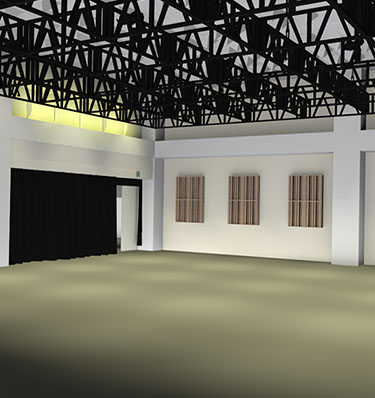3D 數位模擬預演系統
軟體特色
The purpose of the Digital Simulation of Performing Arts (DSPA) system is to serve creative teams of theater performing arts, to provide performance and creation groups with a digital simulation integration tool that was developed domestically. The system includes seven subsystems, including “Director, Stage, Lighting, Audio, Imaging, Effects and Character” that allow stage sets, lighting changes, soundtracks and image projection contents to be set individually; the point of time for all screen transitions can also be controlled freely, just like a stage supervisor executing the entire show. Any seats and angles within the theater can also be simulated to observe and appreciate all designed results.
Photorealistic Lighting Effects
A powerful 3D animation engine is used to simulate real lightings in professional theaters and display different technical specifications and illuminance. Effects such as brightness, angle, position, effect sheets, colored-paper, palette, soft light and light beam can all be freely adjusted. Gamma 2.0 setting is used for the dimming curve, providing light changes that best match the visual sensations in theaters.
Import 3D model
Various theater space databases from the Taiwan Traditional Theater Center are built-in, so it is equipped with the 3D models of technical equipment including curtain, lighting, speakers, rotating stage, projector and masking etc. You can also customize or import 3D models drawn by yourself, and import customized stage props into the system for use (supports the .FBX file format).
Export Various Charts
All seven subsystems have the function to output charts, including light setting diagram, light focus diagram, stage object layout, props list and music video list etc. Related personnel can refer to these forms while working whether during the creation or performance periods, effectively improving communication efficiency and reducing production cost.
Use with VR
Enter the theater through virtual reality; experience the performance you designed in full-scale. You can walk around technical spaces including the auditorium, stage and even the lighting catwalks etc. to understand the structure and the composition inside the theater more intuitively. This function only supports HTC VIVE; if this equipment is not available, 360° panoramic video outputted by this system can also be used with mobile phones to experience the VR effects.
Origin
2014—Fighting for funds
National Center for Traditional Arts was established in response to the Taiwan Traditional Theater Center and the rapid increase of performance venues domestically and abroad. Also, in consideration that performance art teams can apply 3D digital technology to effectively improve and control performance qualities during creative development, as well as control production cost and work efficiency, therefore in 2014, funds were applied from the “Chinese Opera Stage‧Technology Integration Project” ran by the Ministry of Science and Technology to develop this system.
2016—Development Completed
It started with a simple concept and been through the brainstorming of theater enthusiasts, and also the participation and development of outstanding domestic information vendors, this system was completed in 2016. It was Taiwan’s first domestically-developed high performance simulation of performing art software aimed for professional theater art work.
2018-2019—Optimization Adjustments
The 3D engine core was rewritten and increased computation speed significantly; virtual reality applications were also expanded and the chart output function was also added, taking the first step toward connecting simulations with actual work.
2020—Officially Launched
Dedicated website was officially launched to the public and this system program was opened for free downloading.
Thanks to every theater professional, information professional and performance team etc. who participated in the development process; your hard work allowed a wish to become reality.
Future Prospect
In order to expand the service range and usage benefits, the recent work goal of the “3D Digital Simulation of Performing Arts” is to collect user opinions extensively and learn the flaws and insufficiencies of the system as bases for future adjustments. We will also:
Actively cooperate with schools: To train seed teachers for the system and introduce course applications, hoping to connect professional training of theater technology with operation of actual cases to increase system utilization.
Integrate venue promotion activities: Through activities and performances from the National Center for Traditional Arts, allow the general public to better understand and become more interested in performance arts by getting closer to theater space through the VR of this system.
Expand to the international market:This system currently already includes an English version; we want to let international theater enthusiasts see the efforts and results of Taiwan through promotions.
Further system optimization and expansion of space and equipment models is planned for this system in 2021. We wish to increase the construction rate for theater and professional equipment modules, as well as technical parameters through cooperation with domestic performance art venues. Also starting from the users’ angle and aiming to use professionalism and friendliness to optimize the user interface and 3D model import interface function, improving overall usage convenience, hoping it can become practical theater tool software.
Your opinion and usage will be the best driving force for the improvement of this system; we welcome your support and input.




